By Sharon Boswell
and Lorraine McConaghy
Special to The Times
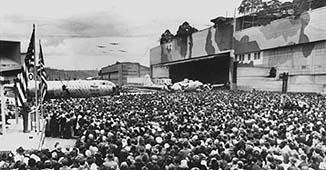
In April 1945, thousands of employees gathered on the tarmac at Boeing's camouflaged Plant 2
to mark the complete changeover from B-17 to B-29 production in all Boeing plants.
Here, the B-29 Superfortress is at left, the B-17 Flying Fortress at right.
Photo Credit: Boeing Co.
IN 1941, THOUGHTFUL AMERICANS OPENED THE NEWSPAPER WITH DREAD.
Japanese aggression in Asia had begun in 1931; Italian and
German aggression in Europe and North Africa in 1935. Times headlines had
chronicled the steadily advancing conquests of coastal China, the Rhineland,
Ethiopia, Austria, Czechoslovakia, Albania, Poland, Norway, the Low Countries,
France, Yugoslavia and Greece, the air war against Britain, and the invasion of
the Soviet Union. By 1941, the world was savaged by wars and rumors of wars.
But isolationist sentiment remained strong in the United States.
In 1939, a local furniture store hired an actor to pose as Adolf Hitler, goose-stepping
to publicize a big sale. The largest Eastside newspaper editorialized in 1941 that
"no American boy (should) be sent to fight on foreign soil in Europe or Asia."
The fighting was distant, someone else's problem.
President Franklin Roosevelt struggled to find ways short of
war to halt the Japanese and German war machines, supplying allies through the
Lend-Lease program and slapping an embargo on scrap metal and oil shipments to Japan.
Seattle's homefront began on a quiet Sunday, Dec. 7, 1941. Panicky
announcers interrupted radio programs with the bulletin that Japanese bombers had
attacked the U.S. base at Pearl Harbor, in Hawaii. The surprise attack had crippled
the Pacific fleet and killed nearly 2,500 men, turning isolationists into belligerents
overnight. Within four days, the United States declared war on Japan and her Tripartite
allies, Italy and Germany.
Scanning the skies for bombers, searching the water for submarines,
Seattle prepared for invasion. The superintendent of a Kirkland shipyard spent a watchful
Pearl Harbor night on the outfitting dock, cradling his rifle; a Seattle mother
stayed up to bake bread and sew winter clothes for her children. She feared that her
family would become refugees, bombed out of their home, living off the land and wandering
the West.
Over the four years of the U.S. involvement in World War II, 16 million Americans
left their homes for the frontlines, and 9 million went off to the homefront as
"soldiers of production," surging out of the heartland to new jobs and new lives.
American industry mobilized to arm and supply a multiple-front war.
In the first six months of 1942, the government placed more than $100 billion in war orders,
from blankets to bombers.
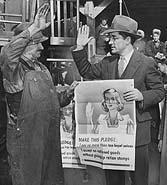
At a Seattle-Tacoma Shipbuilding rally, shipfitter Mathias Herberholz takes the Homefront Pledge, vowing to shun the black market for scarce goods and to abide by Office of Price Administration guidelines. Photo Credit: Seattle Times.
THE LOCAL IMPACT OF MOBILIZATION WAS DRAMATIC. King County coal mines
reopened, and Douglas fir was declared a strategic material. Puget Sound
shipyards built hundreds of destroyers, tenders and carriers.
For the duration, Boeing's Plant 2 disappeared beneath a fantastic tent,
appearing from the air to be a countryside of houses, fields and pastures,
dotted by cows and trees. Underneath this make-believe world, Boeing manufactured
the B-17 Flying Fortress and then the B-29 Superfortress.
Roosevelt, in his third term, met wartime emergency as he had met economic
emergency. FDR paternally explained at a 1943 press conference that when the U.S. had been bedridden
with the Great Depression, Dr. New Deal had overseen the patient's care. But recently
the nation had suffered a terrible accident, and Dr. Win-the-War took over the case.
When homefront crises threatened, from manpower shortages to inflation, Roosevelt's
"medicine" was an alphabet soup of federal agencies. The War Production Board,
the Office of Price Administration, the War Manpower Commission, the War Relocation
Authority and the Fair Employment Practice Commission became part of every American's daily life.
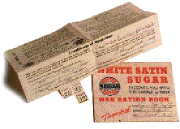
At right, a local housewife's wartime ration book, carefully clipped of its "points" for scarce food. Photo Credit: Lotte Chase.
MEAT, GAS AND TIRES WERE RATIONED BEFORE THE INTERNMENT OF AMERICANS OF JAPANESE DESCENT -- sugar, shoes, and other staples soon followed. King County people collected scrap metal and rubber, saved cooking fats, planted Victory gardens, and baked cookies to send overseas. They coped with the intricacies of their ration books and endured shortages of every sort.
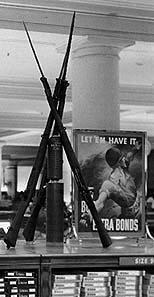 At left, the homefront brought high drama to Frederick and Nelson's glove and hosiery
display.
At left, the homefront brought high drama to Frederick and Nelson's glove and hosiery
display.
Photo Credit: Museum of History and Industry.
HOMEFRONT FASHION ECONOMIZED ON FABRIC,offering men's suits with
cuffless trousers and no
vest; women's skirts rose and most pleats and frills disappeared. Baggy rayon hose --
or leg paint with an eye-brow penciled seam -- replaced silk stockings. Civilians couldn't
buy a new car at any price; rickety homefront furniture was a standing joke. From roller
skates to perfume, people couldn't buy what they really wanted but everybody had a
job and money to burn.
The Depression had finally ended.
As men were drafted into the frontlines, new industrial jobs opened for women,
racial minorities and the unskilled. The trades were broken down into simple tasks,
standardized for multiple production and rapid training. Women responded to homefront
appeals, reassured that riveting an airplane was just like pinning a dress pattern.
By 1944, half the workers at Boeing were female.
Recruited nationwide, the urban and rural white poor, African Americans,
and the footloose and venturesome flocked to defense-industry jobs.
The housing crunch was acute -- families lived in chicken coops and garages until
dormitories and apartments were built to accommodate them. Dustbowl refugess from Oklahoma and Arkansas,
disparagingly called "Okies" and "Arkies," seen as drawling hayseeds, became the butt of
cruel homefront humor.
During the war, Seattle's black population increased from 4,000 to nearly 30,000,
as young men and women were recruited to wartime jobs. The city's unwritten rules
of prewar behavior extended to the homefront, barring African-American women from
trying on gloves in downtown department stores or young black couples from dancing at
the Trianon Ballroom.
As a major production center and port of embarkation, Seattle became geared to war,
a hard-working, hard-playing boomtown that never slept. Crowded and intense,
the city was jumping 24 hours a day -- day, swing and graveyard shifts --
flush with high wartime wages, full of soldiers and sailors, welders and riveters on the town.
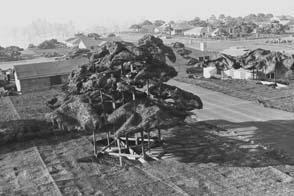
At right, a fake neighborhood of net and burlap, 2-by-4's and plywood was built on top of Boeing's Plant Two to camouflage it from enemy bombers. Photo Credit: Boeing Co.
PEOPLE LOOKED HARD FOR A GOOD TIME, surrounded by posters badgering them to produce,
conserve, give blood, not hoard and not shirk, keep a tight lip, and -- above all --
buy war bonds to pay for victory.
Throughout the war, Seattle's homefront stage for bond rallies, entertainment,
patriotic ceremonies and political speeches was downtown's Victory Square.
Among scores of celebrities, Eleanor Roosevelt, Duke Ellington, and Lana Turner
visited the Square, with its models of the Washington Monument and Thomas Jefferson's
home at Monticello. During the spring and summer, Victory Square provided six programs
a week to cheer Seattle people and encourage them not to lose heart.
Local civilian defense teams organized to direct
mass evacuation, or to cope with an invasion or air attack. They went door-to-door,
enforcing blackout regulations. The Times published good advice on dealing with poison
gas and burns from incendiary bombs, urging jittery readers to clip and post the basic
air-raid rules: Keep calm. Stay home. Put out the lights. Lie down. Stay away from windows.
Don't use the telephone.
Despite shortages of newsprint, ink and skilled labor, Seattle's
newspapers became essential guides to the homefront. Men left the pressroom and
the newsroom for the war, just as they had left the shipyards, and women became key to
the homefront Times.
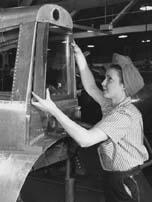
At right, "Rosie the Riveter" assembles the tailgunner's bullet-proof enclosure on a B-29.
Photo Credit: Boeing Co.
LONGTIME PUBLISHER C.B. BLETHEN HAD DIED TWO MONTHS BEFORE PEARL HARBOR,
and the newspaper, set suddenly adrift, was steadied by its critical wartime role.
The Times printed war news, photos and comics; it tracked down rumors and worked hard
to keep up civilian morale. Though the newspaper conducted hard-hitting investigative
reporting on waste and payroll-padding in area shipyards, it never pursued the dark
mysteries of Hanford, just over the mountains.
On Seattle's waterfront, wounded men were carried off hospital ships in
wicker-basket stretchers, to begin their long and painful journey home. The gold stars of
mourning for war dead hung in windows of lonely farmhouses and city apartments, and Seattle
seemed full of young mothers, widowed at 18, left to carry on. As the names of local casualties
were released, they were inscribed on Victory Square's Washington Monument. More than 1,100
King County men and women lost their lives in World War II; its survivors came home heroes.
At the war's end, military contracts were canceled and local layoffs began.
Propaganda urged women to give up the "men's jobs" they had been doing, to "return to the bench."
Many blacks, too, found their industrial jobs lasted only "for the duration." All over King County,
wartime housing was sold and towed away, or torn down. The homefront was temporary.
But there were enduring changes. The Pacific Northwest
had become more cosmopolitan, more industrial, more racially diverse;
it would remain so. The homefront underscored the transformation of the Pacific
Northwest begun by the New Deal as the region was urbanized and industrialized,
shaped to military purposes and accustomed to federal contracts.
Characterized by both opportunism and heroism, by self-sacrifice and petty connivance,
the homefront was rich with ambiguity. But the American "arsenal of democracy"
won World War II, hands down, and the men and women who wore the star-spangled hard hat
on the Seattle homefront shared in that great accomplishment.
Historians Sharon Boswell and Lorraine McConaghy teach at local universities and do research, writing and oral history. Original newspaper graphics courtesy of the Seattle Public Library.